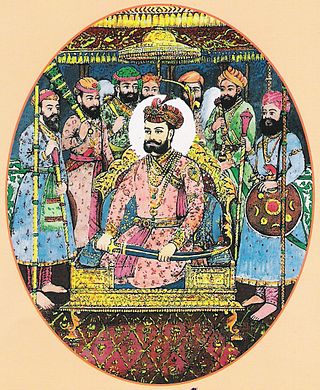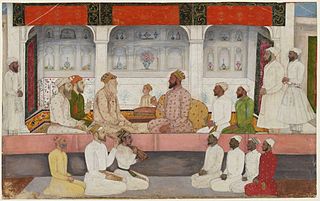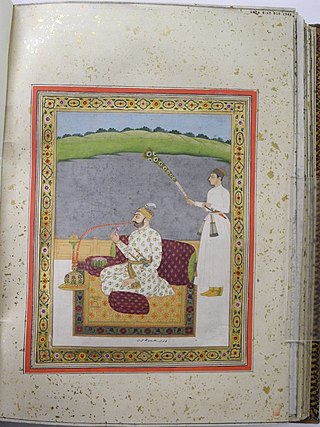
The Second Battle of Panipat was fought on 5 November 1556, between Akbar and Emperor Hemu. Hemu had conquered Delhi and Agra a few weeks earlier by defeating Mughal forces under Tardi Beg Khan in the battle of Delhi. He crowned himself Raja Vikramaditya at Purana Quila in Delhi.

Panipat is an industrial planned city, located in Haryana, India. It is 95 km north of Delhi and 169 km south of Chandigarh on NH-1. The three major battles fought in 1526, 1556 and 1761 took place near the city. The city is famous in India as the "City of Weavers" and "Textile City." It is also known as the "cast-off capital" due to being "the global center for recycling textiles". Panipat is also home to a variety of manufacturing industries, including wool and cotton milling, saltpetre refining, and the manufacture of glass, electrical appliances, and other products. Panipat is included in the list of critically polluted industrial areas in India. As on Dec 2009, the Comprehensive Environment Pollution Index (CEPI) of the city was 59.00, as against 88.50 of Ankaleshwar (Gujarat). The fatal field of Panipat is the site of three battles that changed the course of India's history, resulting in the creation and confirmation of the Mughal Empire. The third battle led to the decisive defeat of the Maratha Confederacy in North India, which became a dominating power in Delhi by then and paved the way for the British colonial rule of India.

Hemu was an Indian king (maharaja) who previously served as a general and Wazir of Adil Shah Suri of the Sur Empire during a period in Indian history when the Mughals and Afghans were vying for power across North India. He fought Afghan rebels across North India from Punjab to Bengal and Mughal forces of Humayun and Akbar in Agra and Delhi, winning 22 battles for Adil Shah Suri.

Muhammad Bairam Khan, commonly known as Bairam Khan or Bayram Khan was an important military commander, and later commander-in-chief of the Mughal army, a powerful statesman and regent at the court of the Mughal Emperors, Humayun and Akbar. He was also the guardian, chief mentor, adviser, teacher and the most trusted ally of Akbar. Akbar honoured him as Khan-i-Khanan, which means "King of Kings". Bairam was originally called Bairam "Beg", but later became honoured as Khan. Bairam Khan was an aggressive general who was determined to restore Mughal authority in India.

Khanzada Mirza Khan Abdul Rahim, popularly known as simply Rahim and titled Khan-i-Khanan, was a poet who lived in India during the rule of Mughal emperor Akbar, who was Rahim's mentor. He was one of the nine important ministers (dewan) in Akbar's court, known as the Navaratnas. Rahim was known for his Hindustani dohe (couplets) and his books on astrology.

Muzaffarnagar district is a district of Uttar Pradesh state in northern India. It is part of Saharanpur division. The city of Muzaffarnagar is the district headquarters. This district is the part of National Capital Region.

The Sayyid brothers were Syed Hassan Ali Khan Barha and Syed Hussain Ali Khan, two powerful Mughal nobles during the decline of the empire.
The Dalpat Vilas is the surviving fragment of a historical manuscript. Written in the Rajasthani language, it is the earliest known Charan source of Mughal-Rajput relations. The initial portion of the manuscript covers the genealogy of the Rathores and the Sur dynasty. The bulk of the manuscript chronicles events in Marwar and adjoining areas during the reign of Akbar.
Mujhera is a village in the Jansath sub-division of Muzaffarnagar District in Uttar Pradesh. It is the seat of the Kundliwal branch of Sadaat-e-Bahra.
Shams ud-Din Ataga Khan was a prominent figure in the court of the Mughal emperor Akbar.
Shaikh Gadai Kamboh was a Punjabi Muslim Sufi saint. He was the son, disciple and successor of famous scholar, philosopher and poet-laureate Shaikh Jamali Kamboh of Delhi and brother of the 'Master of Expression' —Shaikh Abd-al-Hai Hayati. His real name was Abdur Rehman but he became famous as Gadai. He was well-renowned for his sanctity and learning and was in high favour with emperor Humayun and Bairam Khan. He is also said to have remained a Musahib of the Afghan emperor Salim Shah Suri. During Akbar’s reign, he occupied the high office of “Sadr-i-sadur” of Hindustan.

Nawab Sayyid Abdullah Khan I also known as Sayyid Mian I, was the father of Hassan Ali Khan Barha and Hussain Ali Khan Barha, the two famous Sayyid Brothers. His full name was Sayyid Abdullah Khan Tihanpuri, Tihanpur was the ancestral village of this branch of Sayyids in Patiala.

Nawab Sayyid Hassan Ali Khan Barha, also known as Qutub-ul-Mulk, Nawab Sayyid Mian II, Abdullah Khan II, was one of the Sayyid brothers, and a key figure in the Mughal Empire under Farrukhsiyar.
Ahmad Khan Barha was a powerful general in Mughal Emperor Akbar's army during the 16th century.

Hemu's Smadhi Sthal, is a memorial to the Hindu king Hemu at Shodapur village on Jind road near Panipat city in Panipat district of Haryana state in India. It stands at the location where he was executed.

The Jal Mahal, also known as the Jal Mahal of Narnaul or the Water Palace, is a late 16th century palace, fortification, and artificial lake located in Narnaul, Haryana. Built by a Mughal governor of Narnaul, the structure currently serves as a tourist attraction.
Shah Quli Khan was a 16th-century Mughal official, nawab (governor), and art patron. Shah Quli served as the Mughal nawab of Narnaul, India, and notably constructed a number of historic sites in the state.

The Barha family was a Shi'a Indian Muslim noble family in India during the era of Delhi Sultanate and Mughal Empire.
Jamal-ud-Din Barah was an Indian Muslim noble in the early Mughal Empire in the court of Akbar. He belonged to the Sadaat-e-Bara. He was the son of Mahmud Khan Barah, and his relative Sayyid Shujaat Khan Barah was governor of Allahabad. Jamal-ud-Din Barah had a love affair with Siyah Yamin, a dancing girl of the Emperor Akbar. He then fled to the mountains and collected a force and gave himself up to looting the parganas of Gujarat and robbed its highways. He was finally captured by Sayyid Qasim and sent to Lahore, where he was executed by arrows.












